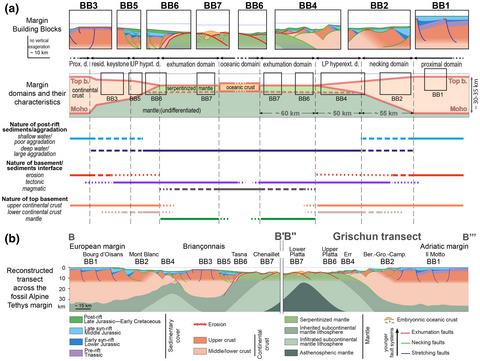当前位置:
X-MOL 学术
›
Basin Res.
›
论文详情
Our official English website, www.x-mol.net, welcomes your feedback! (Note: you will need to create a separate account there.)
The syn‐rift tectono‐stratigraphic record of rifted margins (Part I): Insights from the Alpine Tethys
Basin Research ( IF 3.2 ) Pub Date : 2021-10-25 , DOI: 10.1111/bre.12627 G. Manatschal 1 , P. Chenin 1 , J.F. Ghienne 1 , C. Ribes 2 , E. Masini 3
Basin Research ( IF 3.2 ) Pub Date : 2021-10-25 , DOI: 10.1111/bre.12627 G. Manatschal 1 , P. Chenin 1 , J.F. Ghienne 1 , C. Ribes 2 , E. Masini 3
Affiliation

|
The tectono-stratigraphic evolution of rift systems is at present poorly understood, especially the one preceding the onset of oceanic seafloor spreading. Improving our understanding of the complex, polyphase tectonic evolution of the fossil Alpine Tethys, one of the best calibrated magma-poor rift systems worldwide, offers great potential for the interpretation of the distal part of global rifted margins, which notoriously lack data. In this paper, we propose a tectono-stratigraphic model for the former Alpine Tethys, whose remnants are exposed in the Alps of Western Europe. We first review the historical evolution of some concepts grounding present knowledge on the Alpine- and global magma-poor rifted margins. Then we present a spatial and temporal template for the Alpine Tethys rift system using a ‘building block (BB)’ approach. This new approach is powerful in that it can integrate high-resolution, structural, stratigraphic, thermochronological, and petrological observations from dismembered outcrops into a margin-scale template compatible with the first-order seismic architecture defined at present-day, magma-poor rifted margins. The detailed analysis of the syn-rift sequence of the Alpine Tethys margins demonstrates that extension migrated and localised while evolving from the stretching to the necking phase. During hyperextension, rifting was asymmetric and controlled by in-sequence detachment faulting. Then, the rift system evolved back into a more symmetric, embryonic spreading system. With this contribution, we aim to allow readers without knowledge of the Alps to access this unique ‘archive’ preserving some of the world's best-exposed rift structures. Recognising these structures is critical to understand the origin of some new concepts used to explain present-day, deep-water rifted margins, and to interpret and predict the tectono-stratigraphic evolution during advanced stages of rifting.
中文翻译:

裂谷边缘的同裂谷构造地层记录(上):来自高山特提斯的见解
目前对裂谷系统的构造地层演化知之甚少,尤其是在大洋海底扩张开始之前的那个。提高我们对高山特提斯化石复杂的多期构造演化的理解,这是世界上校准最好的贫岩浆裂谷系统之一,为解释全球裂谷边缘的远端部分提供了巨大的潜力,众所周知,这些裂谷边缘缺乏数据。在本文中,我们提出了前高山特提斯的构造地层模型,其遗迹暴露在西欧的阿尔卑斯山。我们首先回顾了一些概念的历史演变,这些概念基于目前关于高山和全球岩浆贫瘠裂谷边缘的知识。然后,我们使用“积木(BB)”方法提出了高山特提斯裂谷系统的时空模板。这种新方法的强大之处在于它可以将来自被肢解露头的高分辨率、结构、地层、热年代学和岩石学观测结果整合到一个边缘尺度模板中,该模板与当今定义的一阶地震结构相兼容,岩浆贫乏裂谷边距。对高山特提斯边缘的同裂谷序列的详细分析表明,在从拉伸阶段演变为颈缩阶段的同时,伸展运动和局部化。在超伸过程中,裂谷是不对称的,并由顺序分离断层控制。然后,裂谷系统又演变成一个更加对称的、萌芽的传播系统。通过这项贡献,我们的目标是让不了解阿尔卑斯山的读者能够访问这个独特的“档案”,其中保存了一些世界上暴露最好的裂谷结构。
更新日期:2021-10-25
中文翻译:

裂谷边缘的同裂谷构造地层记录(上):来自高山特提斯的见解
目前对裂谷系统的构造地层演化知之甚少,尤其是在大洋海底扩张开始之前的那个。提高我们对高山特提斯化石复杂的多期构造演化的理解,这是世界上校准最好的贫岩浆裂谷系统之一,为解释全球裂谷边缘的远端部分提供了巨大的潜力,众所周知,这些裂谷边缘缺乏数据。在本文中,我们提出了前高山特提斯的构造地层模型,其遗迹暴露在西欧的阿尔卑斯山。我们首先回顾了一些概念的历史演变,这些概念基于目前关于高山和全球岩浆贫瘠裂谷边缘的知识。然后,我们使用“积木(BB)”方法提出了高山特提斯裂谷系统的时空模板。这种新方法的强大之处在于它可以将来自被肢解露头的高分辨率、结构、地层、热年代学和岩石学观测结果整合到一个边缘尺度模板中,该模板与当今定义的一阶地震结构相兼容,岩浆贫乏裂谷边距。对高山特提斯边缘的同裂谷序列的详细分析表明,在从拉伸阶段演变为颈缩阶段的同时,伸展运动和局部化。在超伸过程中,裂谷是不对称的,并由顺序分离断层控制。然后,裂谷系统又演变成一个更加对称的、萌芽的传播系统。通过这项贡献,我们的目标是让不了解阿尔卑斯山的读者能够访问这个独特的“档案”,其中保存了一些世界上暴露最好的裂谷结构。



























 京公网安备 11010802027423号
京公网安备 11010802027423号